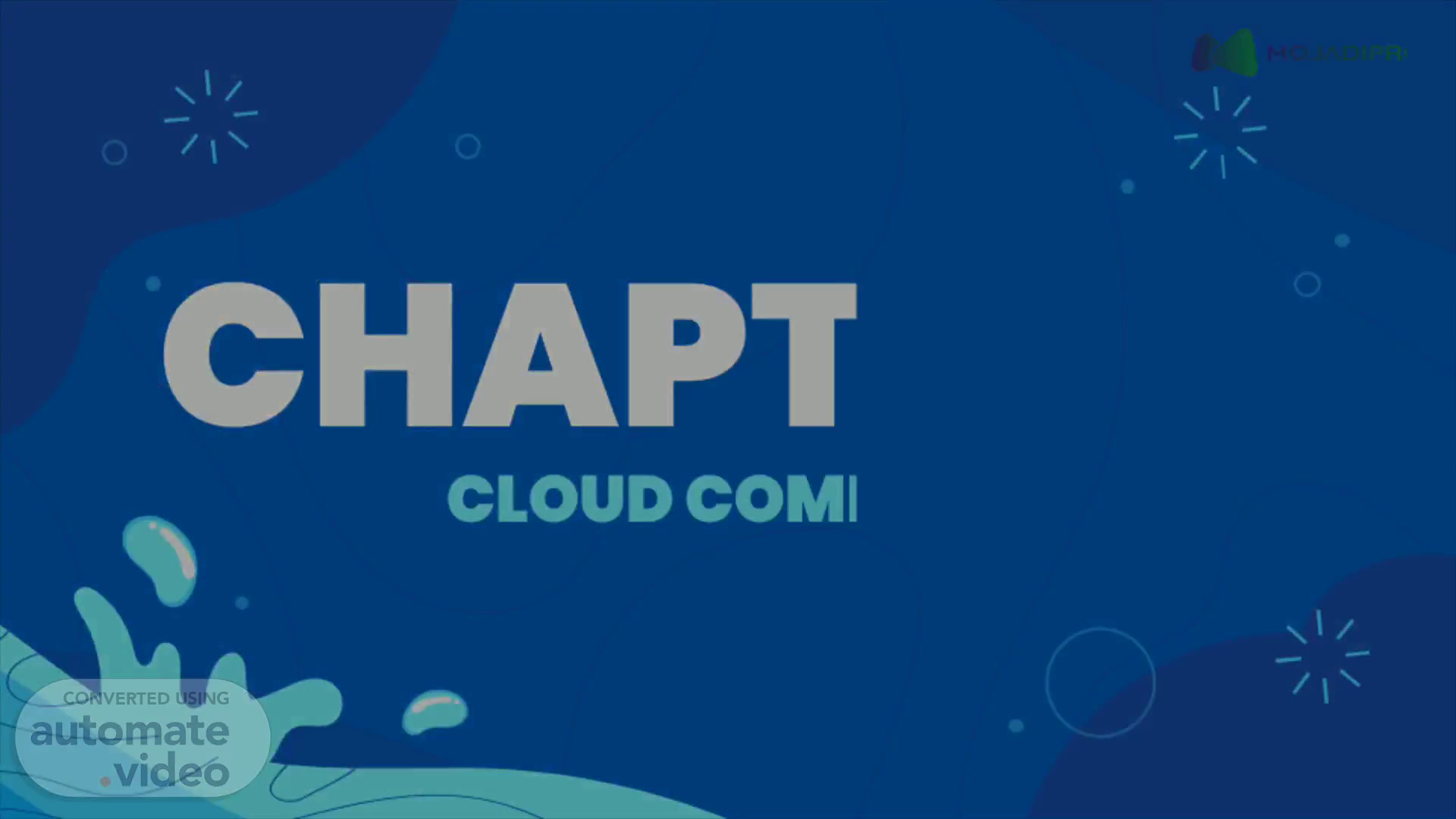
CHAPTER 4 CLOUD COMPUTE
Scene 1 (0s)
CHAPTER 4 CLOUD COMPUTE.
Scene 2 (8s)
COMPUTE INTRODUCTION. CLOUD COMPUTE. 01. CPU CAPABILITIES.
Scene 3 (20s)
ENERGY SAVINGS. CLOUD COMPUTE. 06. DEDICATES VS. SHARED COMPUTE.
Scene 4 (34s)
POLICIES. CLOUD COMPUTE. 11.
Scene 5 (42s)
01. COMPUTE INTRODUCTION.
Scene 6 (49s)
CLOUD COMPUTE DEFINED. Computer calculations in the cloud.
Scene 7 (59s)
CLOUD COMPUTE BENEFITS. Dynamic performance improvement.
Scene 8 (1m 15s)
CLOUD COMPUTE CHALLENGES. Latency of results - Traffic has to cross the Internet and back.
Scene 9 (1m 28s)
CONCLUSION OF COMPUTE INTRODUCTION. Cloud compute is computer-based calculations and processing in the cloud.
Scene 10 (1m 48s)
02. CPU CAPABILITIES.
Scene 11 (1m 56s)
CENTRAL PROCESSING UNITS (CPUs). The core compute engine.
Scene 12 (2m 11s)
CPU TECHNOLOGIES. Hyperthreading Multiple threads of concurrent operation Results in multiple virtual CPUs For example, a 4-core hyperthreaded CPU=8 virtual CPUs.
Scene 13 (2m 25s)
OVERCOMMITMENT RATIOS. Utilize real resources for virtual machines well Scenario: • 2 CPUs • Each is quad core • Each is hyperthreaded • Total of 16 virtual CPUs • Run 4 virtual machines, each with 8 CPUs • Result is a 2:1 overcommitment ratio - 2 virtual processors for each of the CPUs (including hyperthreading) Overcommitment is the primary factor in private clouds Cloud service providers hide this from you and perform it themselve.
Scene 14 (2m 46s)
CONCLUSION OF CPU CAPABILITIES. The CPU is the core compute engine and cloud providers offer varying levels of capability.
Scene 15 (3m 6s)
03. MEMORY REQUIREMENTS.
Scene 16 (3m 14s)
W HAT ARE THE FACTORS OF MEMORY REQUIREMENT?. 1. Operating system.
Scene 17 (3m 27s)
MEMORY BALLOONING. A feature of virtualization platforms • Unused, allocated memory for one guest can be used by another • Allows for overcommitment of memory Mostly used in private clouds from a configuration perspective • Service providers may used it, but you won’t configure it Bursting • The action of ballooning.
Scene 18 (3m 44s)
CONCLUSION OF MEMORY REQUIREMENTS. Consider everything running on a virtual machine when determining memory requirements.
Scene 19 (4m 0s)
04. PERFORMANCE CONSIDERATION.
Scene 20 (4m 8s)
PERFORMANCE FACTORS. CPU. MEMORY. DISKS. NETWORK.
Scene 21 (4m 17s)
DEMO. Optimizing CPU options in AWS https://docs.aws.amazon.com/AWSEC2/latest/UserGuide/instance-optimizecpu.html.
Scene 22 (4m 39s)
CONCLUSION OF PERFORMANCE CONSIDERATION. CPU and memory are the primary performance factors specifically for compute.
Scene 23 (4m 56s)
05. COST CONSIDERATIONS (LAB).
Scene 24 (5m 4s)
HANDS-ON. Azure Pricing Calculator https://azure.microsoft.com/en-us/pricing/calculator.
Scene 25 (5m 21s)
CONCLUSION OF COST CONSIDERATIONS (LAB). Costing in the cloud is a combination of desired resources and performance requirements.
Scene 26 (5m 38s)
06. ENERGY SAVINGS.
Scene 27 (5m 45s)
PUBLIC / COMMUNITY CLOUD ENERGY SAVINGS. Shared resources = Energy savings.
Scene 28 (5m 55s)
TRADISIONAL PRIVATE DEPLOYMENTS. Departmental servers.
Scene 29 (6m 9s)
PRIVATE CLOUD DEPLOYMENT ENERGY SAVINGS. Virtualization changed everything Private cloud is basically automated virtualization • With some extra bells and whistles The new deployment that saves energy • Multiple virtual servers on a single box • Services accessed across the Internet in the private cloud • Virtual desktops with high computing power - Possible shared among multiple resources.
Scene 30 (6m 26s)
CONCLUSION OF ENERGY SAVINGS. Shared resources in the public and community clouds results in overall energy savings.
Scene 31 (6m 45s)
07. DEDICATED vs. SHARED COMPUTE.
Scene 32 (6m 53s)
DEMO. AWS Dedicated Hosts and Instances https://docs.aws.amazon.com/AWSEC2/latest/UserGuide/dedicatedhosts-overview.html.
Scene 33 (7m 10s)
CONCLUSION OF DEDICATED vs. SHARED COMPUTE. A dedicated host is a physical server that is used only for your instance(s).
Scene 34 (7m 30s)
08. HIGH AVAILABILITY AND DISASTER RECOVERY FOR COMPUTE.
Scene 35 (7m 38s)
HA/DR EFFECT FOR COMPUTE. High availability and disaster recover (HA/DR).
Scene 36 (7m 52s)
HA/DR EFFECT FOR COMPUTE. Availability functions for compute Clustering - Multiple instances with a primary and failover Load balancing - Multiple instances with workload rotating between them Serverless limits - Imposed by service provider.
Scene 37 (8m 4s)
DEMO. AWS Lambda Limits https://docs.aws.amazon.com/lambda/latest/dg/limits.html.
Scene 38 (8m 16s)
CONCLUSION OF HIGH AVAILABILITY AND DISASTER RECOVERY FOR COMPUTE.
Scene 39 (8m 36s)
09. MONITORING (LAB).
Scene 40 (8m 43s)
MONITORING TERMINOLOGY. TARGET OBJECT. ALERTS. Baselines Anomalies.
Scene 41 (8m 53s)
EVENT CORRELATION. Event timestamps are used to correlate Ex: • Event A happened at 10:17:32 and Event B happened at 10:17:33 • Event B and A are related • Maybe Event B was caused by Event A Correlation benefits • Determination of cause • Locating attack points • Identifying errant code.
Scene 42 (9m 10s)
CONCLUSION OF MONITORING (LAB). An anomaly is an event outside of the ordinary expectations.
Scene 43 (9m 26s)
10. FORECASTING.
Scene 44 (9m 33s)
KEYPOINTS OF FORECASTING REQUIRED RESOURCES. Forecasting is looking into the future to determine needs - Look at today to predict tomorrow.
Scene 45 (9m 47s)
Upsize/increase or downsize/decrease resources to meet future demands - CPU - Memory - Storage.
Scene 46 (9m 56s)
CONCLUSION OF FORECASTING. Forecasting is about looking at yesterday and today to predict tomorrow.
Scene 47 (10m 12s)
11. POLICIES.
Scene 48 (10m 19s)
KEYPOINTS OF POLICIES AND MONITORING. Monitoring may reveal sensitive data - Can monitor down to the process level - Identifying processes can give you insight into points of attack.
Scene 49 (10m 33s)
Policies in support of event collection - What can be monitored? - When should it be monitored? - What can be correlated?.
Scene 50 (10m 46s)
CONCLUSION OF POLICIES. Monitoring can reveal sensitive data.